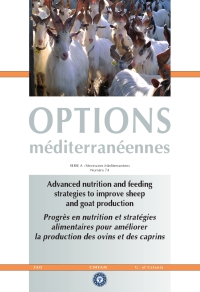| Article précédent | p. 251-255 | Article suivant |
Effect of the administration of polyethylene glycol (PEG) on the milk fatty acid composition of sheep grazing Sulla (Hedysarum coronarium)
Tannins are naturally occurring polyphenols found in many forage plants that reduce their nutritional value through an inhibitory effect on ruminal and intestinal functions. Daily supplementation with polyethylene glycol (PEG) has been proven to efficiently neutralise the negative effect of tannins. A grazing experiment was undertaken to evaluate the effect of PEG supplementation on animal performance and milk fatty acid composition of Sarda sheep grazing sulla (Hedysarum coronarium). Twenty-four late-lactating sheep (12 per group), were paired and split into two groups: group CON daily dosed by a quenching gun with 200 ml of water, and group PEG, dosed with 200 ml of a 50/50 water solution of PEG. The sheep rotationally grazed two 0.8 ha plots of sulla. Milk yield tended (P<0.13) to be increased by PEG. Milk fat and protein contents were not affected by the treatment. The CLA (C18:2 c-9, t-11) and vaccenic acid (C18:1 t-11) contents in milk fat were higher on average by 40% for PEG than CON group. This can be explained by a higher biohydrogenation activity of ruminal bacteria in the PEG group, due to the partial inactivation of tannins. Actually both linoleic (C18:2 c-9 c-12) and linolenic (C18:3 c-9 c-12 c-15) fatty acid were lower (P<0.05) in milk from PEG than CON group (-12% and -30% for linoleic and linolenic acids, respectively).
Les tannins sont des polyphénols que l'on trouve à l'état naturel dans de nombreux fourrages, qui réduisent la valeur nutritive et ont un effet inhibiteur sur les fonctions digestives des ruminants. Une complémentation quotidienne de polyéthylène glycol a été expérimentée pour neutraliser ces effets négatifs. Un essai au pâturage sur Hedysarum coronarium avec des brebis laitières a été conduit afin d'évaluer l'effet de la complémentation avec PEG sur les performances des animaux et sur la composition en acides gras du lait. Vingt-quatre brebis en fin de lactation (12 par groupe) ont été divisées en deux groupes : un groupe témoin (CON) dosé chaque jour avec 200 ml d'eau, et un groupe supplémenté (PEG) avec 200 ml d'une solution d'eau et PEG (50/50). La production du lait tend (P<0,13) à augmenter par l'administration du PEG. La composition en matières grasses, en protéines du lait n'a pas été affectée. La composition en CLA (C18:2 c-9, t-11) et en acide trans-vaccénique (C18:1 t-11) dans la matière grasse du lait est en moyenne plus élevée (+40%) dans le groupe PEG. Ceci peut s'expliquer par une activité de biohydrogénation des bactéries du rumen dans le groupe PEG due à une inactivation partielle des tannins. La composition en acides gras linoléique (C18:2 c-9 c-12) et linolénique (C18:3 c-9 c-12 c-15) du lait de brebis complémentées avec du PEG est inférieure (P<0,05) à celle du groupe témoin (-12% et -30% pour les acides linoléique et linolénique, respectivement).
- [ Afficher ]
- [ Télécharger ]
- [ Exporter la citation ]
Vous pouvez télécharger la citation au format :
- [ Imprimer ]
-
Mots-clés
ACIDE GRAS, BREBIS, COMPLEMENT ALIMENTAIRE, DIGESTIBILITE, EXPERIMENTATION, FOURRAGE VERT, LAIT DE BREBIS, PATURAGE, REGIME ALIMENTAIRE, TANNINCiter cet article
Cabiddu A., Decandia M., Addis M., Spada S., Fiori M., Piredda G., Sitzia M., Fois N., Molle G. Effect of the administration of polyethylene glycol (PEG) on the milk fatty acid composition of sheep grazing Sulla (Hedysarum coronarium). In : Priolo A. (ed.), Biondi L. (ed.), Ben Salem H. (ed.), Morand-Fehr P. (ed.). Advanced nutrition and feeding strategies to improve sheep and goat . Zaragoza : CIHEAM, 2007. p. 251-255. (Options Méditerranéennes : Série A. Séminaires Méditerranéens; n. 74). 11. Seminar of the FAO-CIHEAM Sub-Network on Sheep and Goat Nutrition, 2005/09/08-10, Catania (Italy). http://om.ciheam.org/om/pdf/a74/00800387.pdf



